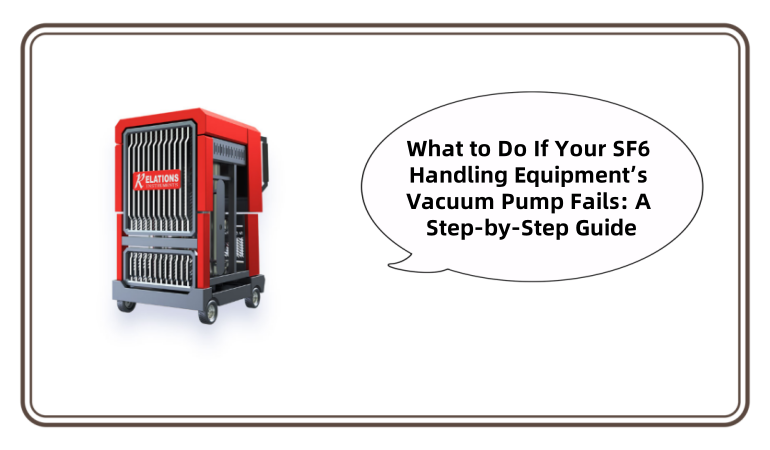- Monday to Friday
- Zhengzhou, Henan, China

SF6 handling equipment is critical for maintaining power systems—from recycling SF6 gas in circuit breakers to purifying it for reuse. At the heart of this equipment lies the vacuum pump, which creates a low-pressure environment to prevent air contamination and ensure SF6 integrity. A vacuum pump failure can halt operations, risk gas leaks (a potent greenhouse gas), or damage expensive gear. Below is a practical, safety-focused guide to resolving the issue.
Safety comes first when dealing with SF6 equipment. If the vacuum pump stops unexpectedly:
Cut power immediately: Turn off the pump’s power switch and disconnect the main power supply to avoid electrical hazards or further component damage.
Isolate the SF6 circuit: Close all valves connecting the pump to the SF6 gas system to prevent uncontrolled gas release or air ingress.
Wear protective gear: SF6 can decompose into toxic byproducts if overheated. Put on nitrile gloves, a face shield, and a respirator (if ventilation is poor) before inspecting the pump.
Ventilate the area: Open exhaust fans or windows to disperse any potential SF6 buildup—this reduces health risks and meets environmental compliance standards.
A failed vacuum pump rarely has a “mystery” cause. Focus on these common issues to narrow down the problem:
Power supply faults: Check if the power cord is frayed, the outlet has voltage (use a multimeter to test), or the pump’s internal fuse is blown. Loose wiring or a tripped circuit breaker are easy fixes.
Oil-related problems: Vacuum pumps rely on specialized oil for lubrication and sealing. If the oil level is below the “min” mark on the sight glass, or the oil is cloudy/black (indicates contamination), this will kill vacuum performance.
Air leaks: Leaks in hoses, gaskets, or pipe connections let air enter, preventing the pump from reaching target vacuum levels. Test for leaks by smearing soapy water on joints—bubbles mean a leak.
Worn components: Over time, pump blades, bearings, or seals wear out. Listen for unusual noises (grinding, squealing) when the pump is off—this signals damaged moving parts.
Once you’ve identified the cause, fix it with these actionable steps:
Power issues: Replace frayed cords, reset breakers, or install a new fuse (match the pump’s voltage rating). For internal wiring faults, consult the equipment manual or a certified technician.
Oil maintenance: Drain old oil completely (use a waste container for proper disposal—SF6-contaminated oil is hazardous). Clean the oil tank with a lint-free cloth, then refill with SF6-compatible vacuum pump oil (never use motor oil). Fill to the “max” mark—overfilling causes foaming.
Leak fixes: Replace cracked hoses or worn gaskets with OEM parts (generic parts may not seal properly). Tighten loose connections with a torque wrench to avoid damaging threads.
Component replacement: If blades or bearings are worn, order replacement parts from the pump manufacturer. Follow the manual’s disassembly steps—misaligning parts can cause more damage. For complex repairs (e.g., motor failure), hire a technician with SF6 equipment experience.
Don’t reconnect the pump to your SF6 system without verifying it works:
No-load test: Turn on the pump without connecting it to the SF6 circuit. It should run smoothly, with no strange noises, and reach a vacuum level of ≤1 Pa (check with a vacuum gauge) within 10–15 minutes.
Load test: Reconnect the pump to the SF6 system and run a short cycle (e.g., 30 minutes of vacuuming). Monitor the vacuum gauge—pressure should stay stable (no sudden spikes, which indicate leaks).
Leak recheck: After testing, use soapy water again on joints to confirm no new leaks developed during repair.
The best way to avoid vacuum pump failures is proactive care:
Check oil level and quality weekly—top up or replace oil as needed.
Inspect hoses, gaskets, and power cords monthly for wear.
Test vacuum performance quarterly to catch small issues early.
Schedule annual professional servicing to clean internal components and replace aging parts.
A failed vacuum pump in SF6 handling equipment is stressful, but resolving it starts with safety, then precise troubleshooting. By following these steps, you’ll minimize downtime, protect your equipment, and ensure compliance with SF6 environmental regulations. Always keep the pump’s manual handy—manufacturer-specific guidelines are critical for safe, effective repairs.
Tell Us What Kind Of SF6 Equipment You Need?
Your email address will not be published.